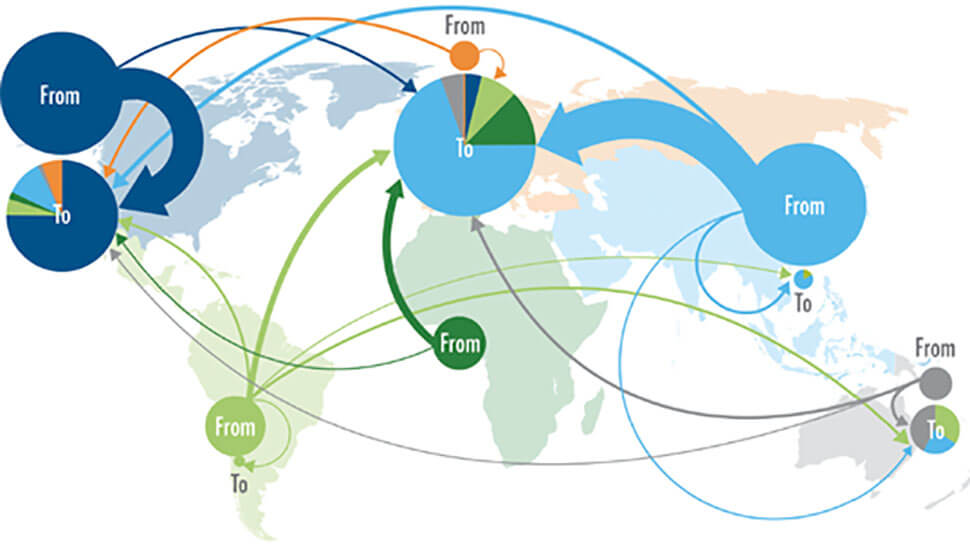 The voluntary carbon credit market is operating independent of the compliance market. After its creation, individuals, businesses and other organizations now have the tool to offset their greenhouse gas emissions by purchasing carbon credits from projects that have achieved factual results in emission reduction. The voluntary carbon trading market is an efficient means of reducing high-GHG energy production through supporting projects concentrating on renewable resources.
The voluntary carbon credit market is operating independent of the compliance market. After its creation, individuals, businesses and other organizations now have the tool to offset their greenhouse gas emissions by purchasing carbon credits from projects that have achieved factual results in emission reduction. The voluntary carbon trading market is an efficient means of reducing high-GHG energy production through supporting projects concentrating on renewable resources.
As of today, this market is still much smaller than the compliance market due to its nature and young age. Yet, experts estimate a dramatic growth in this sector. By 2015, turnover is expected to reach 500 million tones of carbon dioxide expressed in carbon credit equivalent, which is a huge increase compared to the 42 to 45 million tones figure today.
In the voluntary market, project developers, wholesalers and brokers alike have the opportunity to trade carbon credits. Based on the standards used, various types of carbon credits exist in the voluntary market. They are also called VERs, or Voluntary Emission Reduction Units. The highest commercial value is quality, this is the same mechanism as in any segment of commerce and trade.
Carbon credits must be verified and certified by independent organizations entitled to issue certificates in order to be of real commercial value. Carbons credits lacking such verification and certification by officially recognized organizations are of no value, and may not be marketed for neutralization, i.e offsetting procedures.
Carbon credits can be classified based on the nature of the projects generating them, or the local impact they make, or the organization issuing the certificates.
A) Local impact of green projects
Certified carbon credits can be classified under various types according to the projects generating them. They can come from a development that serves the local community. They can be created in the framework of a huge renewable energy project. Additionally, they can represent high-tech innovation, which has less impact of the everyday life of people in the vicinity of the project under implementation.
B) Nature of green projects (hydroelectric power, wind, biomass, afforestation, etc.)
One of the more popular VER types is carbon credits generated by wind farms or hydroelectric power plants with greatly reduced emissions. It is to be noted that these plants can both mitigate GHG emissions to a great degree and have a capacity of producing significant amounts of energy.
Another type of project seeks to reduce greenhouse gas emissions by improving existing production and manufacturing procedures. Furthermore, they also adopt green principles in the area of handling waste or utilizing services indirectly connected to their activities, such as using shipping methods with lower emissions.
Afforestation is one of the most useful ways to neutralize GHGs. Its purpose is to compensate for earlier deforestation, even in other locations, by reforestation, thus restoring a healthy balance between areas with and without forests. Afforestation has an added value of creating natural habitat for hundreds of species, thus indirectly helping the survival of those species.
C) Organizations issuing certificates
VERs in the voluntary market are less regulated and certification costs are also significantly lower that those in the compliance market, nevertheless this does not mean they are not required to comply with strict standards. To get certified, carbon credits must be demonstrated to have come from a project which produces real and measurable reductions in emissions.
Carbon credit certification and verification is carried out by approved certification bodies which consider different sets of criteria. Given that these various bodies work with different standards when certifying carbon credits, each certificate has their own distinct value on the market. The most widely accepted certification standards are the Voluntary Carbon Standard or VCS, the Gold Standard and the Social Carbon..
Why Individuals and Businesses Buy Voluntary Market Carbon Credits?
While the primary motivation to buy carbon credits in the case of individuals is a realization that it is highly necessary for each of us to take responsibility for our environment, in the case of businesses considerations leading to purchasing them can be much more complex.
Enterprises that have adopted an environment-friendly modus operandi can be said to be characterized by choosing the method of reducing their carbon footprint in a way that is most effective from the viewpoint of their business strategy. Offsetting their emission through buying carbon credits is available to all businesses, therefore it is a simple and almost obvious solution.
Common considerations behind purchasing carbon credits by businesses:
•To achieve GHG emission reduction quotas set by the company, especially when the company is not capable of operating with reduced emissions due to cost-effectiveness problems or other reasons.
•To prepare for regulations to be introduced later, or to comply with already existing regulations.
•To reduce business risks by increasing the value of the company in the eyes of potential investors who consider GHG emissions an ever-growing risk because of carbon limitations expected to be introduced in the very near future.
•To support positive environmental changes, such as financing projects that are based on clean energy in order to reduce energy production with high GHG emissions.
•Communications aspects, such as building brands, positioning, and differentiating the company’s products and services from those of the competition (carbon-neutral products could be sold with a higher price-tag, even in the premium category).
•External and internal PR purposes: operating in an environment-friendly manner has value in shaping the company image in a positive way. This is true with business partners, current staff and prospects, customers and even competitors since it creates goodwill for the company.
•Market pressure: large companies are leading the way by becoming more and more committed to a green and environment-conscious business model and they often expect the same of the smaller companies in their supply chain.
•CSR (Corporate Social Responsibility) is a way to express the company’s social responsibility.
Retirement of Carbon Credits
An important or essential stage in the process of offsetting emissions is the retirement of carbon credits on the registry. When retiring carbon credits, in each case the registration organization records the name of the user (whose emission has been offset), the standard, that is the type of project the carbon credits came from, their unique serial numbers, and the name of the organization that issued the certificate. This step is to be done to make sure that retired carbon credits can never go back into circulation, and that the same credits cannot be sold twice.




